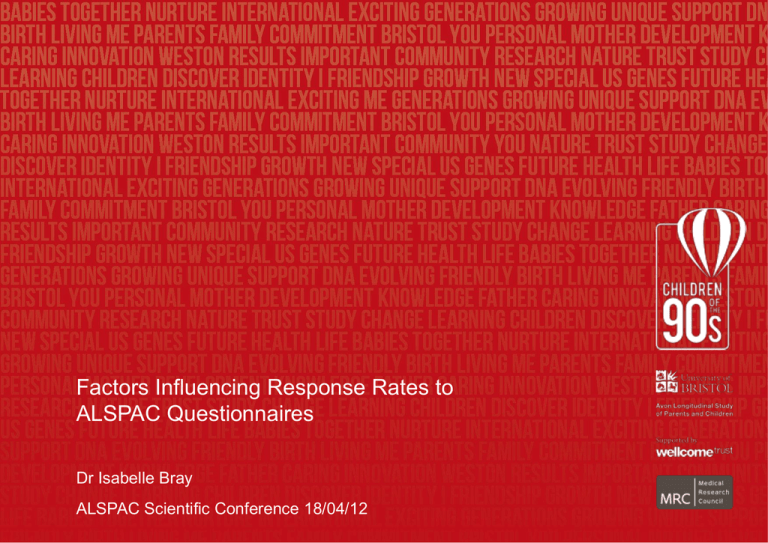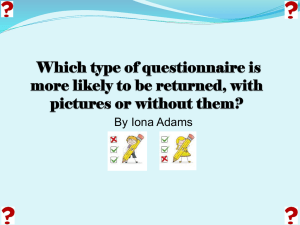
Factors Influencing Response Rates to
ALSPAC Questionnaires
Dr Isabelle Bray
ALSPAC Scientific Conference 18/04/12
“One of the greatest challenges facing
longitudinal surveys is to establish maximum
representativeness of the cohort at the outset
and to maintain this representativeness
throughout the follow-up period”
Large Cohort Studies Across the World, Pirus & Leridon 2010
Initial response to child cohort studies
(UK, US and Canada)
100
95
90
%
85
ALSPAC
80
75
70
1950
1960
1970
1980
1990
2000
2010
Designing Multidisciplinary Longitudinal studies of Human Development: Analyzing Past Research to Inform Methodology,
Shulruf et al. 2007
Reasons for non-response
1. Failure to locate
2. Failure to contact
3. Refusal to take part
Reasons for non-response
1. Failure to locate
Increasing residential mobility
2. Failure to contact
3. Refusal to take part
Reasons for non-response
1. Failure to locate
Increasing residential mobility
2. Failure to contact
More mothers working
Busier lives & increased affluence - more likely to be out
3. Refusal to take part
Reasons for non-response
1. Failure to locate
Increasing residential mobility
2. Failure to contact
More mothers working
Busier lives & increased affluence - more likely to be out
3. Refusal to take part
Sense of obligation to participate appears to have declined over time
Recent studies cover more aspects of participants lives and often
include more intrusive information
Increase junk mail, telesales calls
Why do response rates matter?
Sample size (i) precision of estimates
(ii) ability to look at subgroups
Representativeness/Bias
Participation at 16-18 yrs
Sex - female
Ethnicity – white
Income – FSM
Odds Ratio
95% CI
1.88
1.34
0.51
(1.74-2.03)
(1.10-1.62)
(0.44-0.60)
Cohort Profile: The ‘Children of the 90s’; the index offspring of The Avon Longitudinal Study of Parents and Children,
Boyd et al 2012 (in press)
Response rates to questionnaires
Response rates to questionnaires
Numerator - number of questionnaires completed
Response rates to questionnaires
Numerator - number of questionnaires completed
Denominator
Eligible sample – defined area of Avon, EDD 01/04/91-31/12/92
Enrolled sample – mother or child has provided some data
Sent questionnaire – depends on participants choice & previous
response
Response rates to questionnaires
Numerator - number of questionnaires completed
Denominator
Eligible sample – defined area of Avon, EDD 01/04/91-31/12/92
Enrolled sample – mother or child has provided some data
Sent questionnaire – depends on participants choice & previous
response
Number completed
Number sent
Questionnaire Response
100
Mother
80
%
60
40
20
0
-5
0
5
10
Age of cohort (years)
15
20
Questionnaire Response
Child-based
100
Mother
80
%
60
40
20
0
-5
0
5
10
Age of cohort (years)
15
20
Questionnaire Response
Child-based
100
Childcompleted
Mother
80
%
60
40
20
0
-5
0
5
10
Age of cohort (years)
15
20
Questionnaire Response
Child-based
100
Childcompleted
Puberty
80
%
Mother
60
40
20
0
-5
0
5
10
Age of cohort (years)
15
20
Questionnaire Response
Child-based
100
Childcompleted
Puberty
80
%
Mother
60
Partner
40
20
0
-5
0
5
10
Age of cohort (years)
15
20
Questionnaire Response
Child-based
100
Childcompleted
Puberty
80
%
Mother
60
Partner
40
20
0
-5
0
5
10
Age of cohort (years)
15
20
Factors affecting response
Individual e.g. age, gender, education, marital status
Family e.g. socio-economic status, ethnicity
Organisational e.g. reminders, home visits/phone calls
Analyses of response
1970 British Cohort Study Logistic regression performed separately
for each wave of the study. Gender, mothers age at birth, social class
of father, birthweight, parents’ education, parity and marital status
predicted response.
Non-response in the 1970 British Cohort Study from birth to 34 years
Ketende, McDonald and Dex 2010
UK Millenium Cohort Study. Mobility since wave 1, country, income,
ethnicity, housing tenure, age, education and Child Poverty Index
predicted response at wave 2
The contribution of residential mobility to sample loss in a birth cohort study: Evidence from the first
two waves of the UK Millenium Cohort Study, Plewis et al 2008
Multilevel model of ALSPAC data
Binary dependent variable – questionnaire completed
Multilevel model of ALSPAC data
Binary dependent variable – questionnaire completed
Explanatory variables:
• Individual/Family (e.g. education, marital status, parity)
• Organisational (e.g. length of questionnaire, reminders, home visits)
Multilevel model of ALSPAC data
Binary dependent variable – questionnaire completed
Explanatory variables:
• Individual/Family (e.g. education, marital status, parity)
• Organisational (e.g. length of questionnaire, reminders, home visits)
• Time in study (from first questionnaire)
Multilevel model of ALSPAC data
Binary dependent variable – questionnaire completed
Explanatory variables:
• Individual/Family (e.g. education, marital status, parity)
• Organisational (e.g. length of questionnaire, reminders, home visits)
• Time in study (from first questionnaire)
In addition,
• Initial probability of response
• Decline in response over time
• Relationship between the two
allowed to vary by individual
Final model – Mothers
Age at delivery (years)
Multiple pregnancy (yes/no)
Parity
Ethnicity (baseline white)
Black
Asian
Other
Home ownership (baseline mortgaged or owned)
Rented
Other
Married (yes/no)
Education (4 ordered categories)
Regular smoker pre-pregnancy
Mothers health (4 ordered categories)
Length of questionnaire (per 10 pages)
Reminder (1,2)
Visits (yes/no)
Time in study (years)
OR
1.066
0.66
0.80
1.00
0.63
0.38
0.65
1.00
0.73
0.89
1.15
1.27
0.78
0.86
0.95
1.28
1.47
0.913
95% CI
(1.060-1.072)
(0.49-0.90)
(0.76-0.83)
(0.44-0.91)
(0.23-0.61)
(0.42-1.02)
(0.66-0.80)
(0.72-1.08)
(1.06-1.26)
(1.23-1.32)
(0.73-0.83)
(0.81-0.91)
(0.94-0.97)
(1.19-1.38)
(1.39-1.56)
(0.908-0.917)
Final
Young
model
People,
– Mothers
by gender
Male
100
Female
80
%
60
40
20
0
5
10
15
Age of cohort (years)
20
Final model – Young People
Female (baseline male)
Age at delivery (years)
Multiple pregnancy (yes/no)
Parity
Ethnicity (baseline white)
Black
Asian
Other
Home ownership (baseline mortgaged or owned)
Rented
Other
Married (yes/no)
Education (4 ordered categories)
Regular smoker pre-pregnancy
Mothers health (4 ordered categories)
Length of questionnaire (per 10 pages)
Puberty questionnaire (yes/no)
Reminder (0,1)
Time in study – males (years)
Time in study – females (years)
OR
1.38
1.047
0.69
0.81
1.00
0.73
0.61
1.07
1.00
0.73
0.84
1.08
1.22
0.76
0.85
0.97
0.83
1.44
0.839
0.871
95% CI
(1.28-1.49)
(1.042-1.053)
(0.57-0.84)
(0.79-0.84)
(0.52-1.01)
(0.39-0.94)
(0.72-1.59)
(0.67-0.80)
(0.70-1.01)
(1.00-1.17)
(1.18-1.26)
(0.72-0.80)
(0.81-0.90)
(0.95-0.98)
(0.81-0.86)
(1.41-1.48)
(0.832-0.846)
(0.864-0.878)
Final model – Partners
Age at delivery (years)
Parity
Ethnicity (baseline white)
Black
Asian
Other
Home ownership (baseline mortgaged or owned)
Rented
Other
Married (yes/no)
Education (4 ordered categories)
Regular smoker pre-pregnancy
Mothers health (4 ordered categories)
Length of questionnaire (per 10 pages)
Time in study (years)
OR
1.022
0.84
1.00
0.45
0.33
0.82
1.00
0.74
0.79
1.44
1.22
0.74
0.86
0.91
0.950
95% CI
(1.017-1.028)
(0.81-0.87)
(0.31-0.66)
(0.20-0.55)
(0.53-1.28)
(0.67-0.81)
(0.65-0.97)
(1.32-1.57)
(1.18-1.26)
(0.70-0.79)
(0.81-0.91)
(0.90-0.93)
(0.944-0.955)
Conclusions
Individual/family effects confirm expected findings
Reminders & visits/phone calls improve response rates
Longer questionnaires associated with lower response rates
Time in study – overall drop in response rates over time
Further work - Questionnaires
Modelling continuous variables:
• Length of questionnaire – threshold effect?
• Time in study - consider change-points
More precise measurement – timings of questionnaires &
reminders from administrative data
Other influences – family, school, friends
Further work - Clinics
Clinics – similar analysis for clinic attendance
Substudies – participant burden v benefit of more
frequent contact










